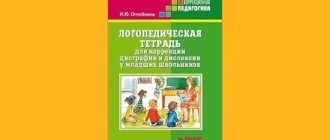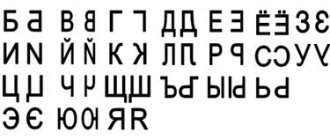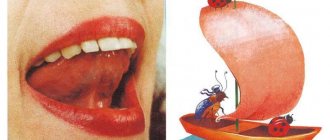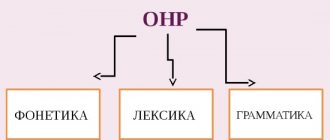This speech disorder is dysgraphia, a fairly “young” concept in the field of pathologies of speech development. Relatively recently, only since the end of the 19th century, this state of children’s speech began to be deeply examined and developed into a separate science. Many researchers, when working with children, noticed and described similar deviations in speech and grammar.
At the initial stage of the study, reading and writing disorders were considered a single disorder. But over time, they began to divide it into narrower concepts: dysgraphia - a writing disorder, dyslexia - a reading disorder. In its pure form, any of the above pathologies are rare. More often than not, reading also suffers along with a writing disorder. Children who demonstrate gross agrammatical violations in writing also deviate from the norm when reading. Therefore, in the conclusions of speech therapists after diagnosing children, you can often find a comprehensive meaning that will look like this: “reading and writing impairment.”
In the early period of studying this problem, it was believed that the initial cause of this pathology was a lack of intellectual development. But over time, it was proven that reading and writing disorders are not associated with intellectual underdevelopment. The examined children with disabilities demonstrated good results in mathematical skills - they solved problems and examples well, thereby showing good logical abilities, which fundamentally contradicts the opinion of mental impairment.
When talking about reading and writing disorders, it is necessary to clarify some points related to terminology. Very often, our Russian patients, when contacting neurologists and speech therapists, confuse such concepts as “dysgraphia” and “dyslexia”. Now in the age of complete availability of information, people have the opportunity to receive news from all over the world. Thus, the concept of “dyslexia” has come into use among Russian citizens; in most cases, as practice shows, this diagnosis is picked up from world-famous Hollywood stars and is actively tried on for themselves. Without fully understanding the meaning of the term “dyslexia,” people are confused about the real condition of the disorder.
In the West, the diagnosis of “dyslexia” is understood as a general combined disorder of reading and writing. Russian speech therapists tend to divide this concept into a narrower meaning: “dysgraphia” is a writing disorder, and “dyslexia” in this case is a reading disorder.
Causes of dysgraphia
For all the time they have been studying this problem, researchers have not come to a consensus about the reasons for its occurrence. Some authors agree with the Soviet neurologist Tkachev, who believed that the cause of reading and writing disorders is poor memory in children. Those. they do not remember letters, syllables, sounds well and therefore cannot correlate sounds with letters.
But there is another opinion, which also found its followers among researchers of this pathology, for example, the Soviet psychiatrist Mnukhin S.S., who insisted that the cause of these problems are negative hereditary factors, such as alcoholism, psychopathy, parental epilepsy, birth injuries. It was also noted that, along with writing impairment, children have a number of other signs. For example, it is difficult for such children to tell about themselves - to give the address, the names of their parents; they mistakenly call the seasons, confuse the days of the week with the months; cannot reproduce the counting and names of the days of the week in strict sequence, even after repeated repetition.
At present, the fragmentation of opinions remains in its original form. Modern authors also identify two possible groups of reasons. The first is associated with a hereditary factor, the presence of similar problems in parents and close relatives. The second group includes organic disorders in the perinatal or postnatal period. Uneven development of the fetal brain structures during pregnancy leads to improper formation of certain functions.
But in modern society, a third direction is also being formed, which is correlated with the cause of the formation of reading and writing impairments - this is the impact of the modern social environment and, therefore, this type of impairment is acquired. Those. Such children do not have hereditary factors, and there are also no organic lesions of the brain structures. This means that the disorder was formed under the influence of incorrectly selected forms of education: untimely start of teaching a child to read and write, developing writing skills at an unacceptably early age, the use of teaching materials that are not appropriate for the age and maturity of the child.
Prevention of writing and reading disorders
This work is carried out with preschoolers and continues in the first grade in the process of teaching literacy. The development of oral speech, the ability to observe language material, its analysis, synthesis, generalization (development of metalinguistic ability), the formation of basic non-speech functions (orientation in space and on a sheet of paper, the development of graphic and motor skills) is the subject of the cooperative work of a speech therapist and teachers, working with children of the appropriate age (educator, teacher). This work allows you to create and strengthen the necessary functional base that ensures the development of literacy.
Photo: Unsplash
Symptoms of dysgraphia
Most often, dysgraphia begins to be identified in elementary school, after the child masters his first writing skills. Already in the second half of the first year of study, you can notice frequently repeated errors of an “incomprehensible” nature. They should not be confused with spelling errors, which would be the norm for an elementary school student. If a student confuses the rules for writing “Zhi-Shi”, or checking for stressed and unstressed words, then this is a natural process in mastering Russian grammar. But if a child persistently writes prepositions together, and prefixes, on the contrary, separately from the word, and also makes many other distortions, which will be discussed in more detail below, then this gives the teacher a reason to recommend that parents visit a speech therapist.
It is very important to understand that dysgraphia does not appear suddenly. The formation of this pathology is based on a long process that begins in early childhood. When diagnosing a disorder, earlier problems that were present throughout the preschool period always come to the surface. All insufficiently formed elements of speech development during the school years move from oral speech to writing. Speech formation disorders are unique to each child, and therefore children’s writing impairments also vary.
If in preschool age the child had a predominant delay in the grammatical form of speech, then the writing will contain errors of a grammatical nature - fused spelling of words and prepositions, etc., if the child in preschool age had problems of a sound nature, then accordingly the writing will be dominated by phonemic type errors.
Types of dysgraphia
There are several forms of dysgraphia:
- articulatory-acoustic dysgraphia;
- dysgraphia based on phoneme recognition disorders;
- dysgraphia due to impaired language analysis and synthesis;
- agrammatic dysgraphia;
- optical dysgraphia;
It is rare that dysgraphia manifests itself in a single form; more often it is of a mixed nature and depends on the severity of the disorders in the preschool period. And then we can see errors in writing that are both grammatical and phonemic at the same time.
For a more complete understanding of how different types of dysgraphia manifest themselves, you can look at the characteristics of these disorders, which were compiled and presented by specialists from the Department of Speech Therapy of Leningrad State Pedagogical Institute named after. A.I. Herzen.
Articulatory-acoustic dysgraphia - this form occurs in children with insufficient development of sound analysis and synthesis. With acoustic dysgraphia, children have difficulty distinguishing sounds. Especially – similar in articulation and sound. In writing, this looks like replacement of letters, confusion and omissions, as well as incorrect reflection of sound pronunciation in writing. Those. the child writes in the same way as he pronounces. Typically, this type of disorder is based on a disorder in preschool age in the form of dyslalia (impaired sound pronunciation), dysarthria, and rhinolalia.
Dysgraphia based on violations of phonemic recognition - with this form in writing, the child replaces phonetically similar sounds (ts-t, ch-sch, p-b, m-, etc..). A feature of this dysgraphia is that in oral speech the child pronounces all sounds correctly. You can also observe in writing a defect in softening (“album”) and replacing vowel sounds - e-i, o-u (hand-“roka”, chalk - “mil”).
Dysgraphia due to a violation of language analysis and synthesis - in writing the structure of sentences and words is distorted, prepositions are written together, prefixes are written separately, individual words are broken (in the forest - “in the woods”, came - “came”, there is a house - “stoidom”). There are omissions of vowels and consonants (work - “rbota”, tree - “dervo”, hat - “shaka”, pear - “rusha”, etc.), addition of extra letters (pines - “pines”), rearrangement of letters and syllables (grass - “gate”).
Agrammatic dysgraphia - is associated with underdevelopment of the grammatical structure of speech, sentences and words are distorted, children have difficulties in forming the plural of nouns, and their diminutive forms are also erroneously formed, the sequence of sentences is not observed, semantic connections are not observed (houses - “houses” , chairs - “chairs”, “many pencils”, chickens - “chickens”, “one nesting doll”, etc.). Such violations are part of lexico-grammatical underdevelopment of speech.
Optical dysgraphia is an unstable visual perception, letters are not recognized and are perceived differently in each word. In writing, such replacements look like this: p-i, p-n, u-i, ts-sch, sh-i, m-l, b-d, p-t, n-k... Mirror writing of letters is also possible, especially for left-handed people.
Motor – often associated with handwriting; in the process of writing, problems arise in the movements of the hand and a violation of the perception of letters with a visual image.
All of these forms of dysgraphia are permanent and stable. In some cases, dysgraphia is accompanied by non-speech deviations, such as impaired memory, distracted attention, and mental illness.
The connection between oral and written speech
Developed oral speech is of great importance for the successful development of writing. In order for a word to be written correctly, the child must hear all the sounds it contains and, after analyzing them, select the desired letter.
Impaired phonemic hearing, which accompanies various delays in speech development, does not make it possible to write words correctly. Incorrect pronunciation of sounds affects their correct understanding and analysis. In cases of more serious hearing impairment, a teacher of the deaf will help you.
In order to master writing, a coordinated development of phonemic hearing, speech, and visual perception of letters is necessary.
In addition, other aspects have a great influence on the formation of written speech. As you know, the left hemisphere is “responsible” for oral speech. Subject symbols and images are the responsibility of the right hemisphere.
The timely development of interhemispheric connections and the formation of the activity of each hemisphere ensure the development of written speech. That is why manifestations of dysgraphia are quite often found in left-handers.
Methods for diagnosing dysgraphia
If you yourself have noticed “funny” writing mistakes that your child makes when doing school assignments, or your class teacher has pointed them out to you, you should consult a speech therapist. The doctor's opinion will be most valuable and reliable if you bring several school notebooks to the appointment.
The need for an integrated approach
Each speech disorder consists of a complex of symptoms. Therefore, the examination of the child must be comprehensive. A neurologist examines for neurological diseases that may interfere with the correct formation of written speech (such as hyperactivity, ADHD, neurosis-like conditions, etc.). A child psychologist will help identify emotional aspects that prevent a child from fully mastering writing, problems with memory and attention. A child psychotherapist will confirm the absence of mental retardation, autism spectrum and mental illness. Additionally, the state of vision and hearing is examined. The speech therapist will establish the level of formation of the grammatical structure of speech, the development of motor functions, the state of phonemic analysis, the consistency of the vocabulary, and deviations in the formation of sound pronunciation.
Sign up for diagnostics To accurately diagnose the disease, make an appointment with specialists from the Family Doctor network.
Treatment: examples of written exercises
There are three ways to treat dysgraphia.
- You can change the form of the letter. If a child struggles with movement disorders, they can write on the computer and transfer their knowledge orally.
- One form of treatment for dysgraphia may also be to change the demands placed on the person affected by this problem.
- The last solution for dysgraphia can be special exercises for the hands, eyes and focus, and to perform them you will need not only a pen and a sheet of paper, but also crayons, paints, markers, and colored paper. In this way, exercise turns into a game.
Treatment of dysgraphia should be carried out using a special set of tasks developed by a psychologist or teacher. These tasks should be selected individually, taking into account the child’s predispositions and capabilities. Some of them:
- drawing “lazy eights” - you need to move your hands in the air, freely drawing big eights,
- correcting and thickening the contours of the image with felt-tip pens, following the line of the drawing,
- tracing the template this could be a template cut out of cardboard with simple shapes at the beginning. You can also ask your child to trace his or her arm or leg on paper.
- drawing with large free movements on paper or other media using a brush, marker, or chalk.
- covering with color one selected part of a sheet of a certain shape, you can ask the child to paint, for example, a square in the corner of the page,
- precise drawing of lines, preferably in checkered notebooks, where the child will find more guidelines when drawing,
- copying a picture, this option can be easier by drawing a grid on the picture and on a blank sheet of paper (it will help you find guidelines for redrawing),
- connecting points with solid lines,
- rewriting letters in lines,
- linking images with corresponding titles. You can draw various objects on a piece of paper and write their names under them, then the child must connect them and then color the pictures.
Dysgraphia is one of the conditions that can be associated with bad memories of school times. It is important to quickly diagnose the problem and begin treatment as soon as possible. If symptoms of dysgraphia are observed in a child, it is necessary to begin occupational therapy with a teacher or psychologist.
dysgraphia with speech therapist
Correction and prevention of dysgraphia
When correcting dysgraphia, it is impossible to do without the intervention of a speech therapist. But without the help of parents, teachers and peers, it is difficult to move.
There is no point in correcting mistakes made. Regardless of what type of dysgraphia your child has, the reason, as we already know, does not lie in ignorance of the rules, and correcting mistakes will not help. Having figured out what the reason is, the issue of correction needs to be approached step by step.
For children who have difficulty distinguishing similar letters by ear - say, hissing and whistling, we gradually explain the difference between them. For example, to explain to a child that the cat has a bowl on the floor, and Mishka is himself, but not vice versa, we record the movements of the lips and tongue at the moment of pronouncing one sound (and the word in which the problematic phoneme is embedded). To remember the connection between the visual image of the letter Ш and muscle movements at the moment of pronouncing the word “Bear”, you can learn to draw these letters with your finger in the air blindly.
Some simple exercises for different types of dysgraphia are available at home. Most likely, you have already thought of well-known games involving making words from cubes and magnets with letters.
For motor dysgraphia, an exercise to draw the exit from the maze is useful: although there is no work with words, drawing a complex continuous line trains the muscle reflexes of the hand. For visual problems, we give exercises for attention and recognition of the external appearance of letters: searching for a given letter in the text (find and underline).
By the way, little things can play a significant role - both negative and positive. For example, for a child with motor skills impairments, we pay attention to the choice of pens. Pens with textured surfaces and ridges or triangular-shaped pencils massage the fingers and increase the number of signals reaching the brain. Therefore, such “inconvenient” writing utensils will better reinforce reflexes.
If at an early age a child shows signs of potential development of dysgraphia, pay attention to whether you yourself are indirectly contributing to this. The environment is an important component. If a child regularly hears illiterate speech from someone in his close circle, he will remember the words incorrectly. And if you are touched by baby babble and “well-aimed” slips of the tongue, this does not mean that you should repeat after the child: “I toze bit” - or: “Hold your bite,” thus reinforcing the incorrect pronunciation.
Our advantages
Prevention of dysgraphia
We work with preschoolers to prevent and eliminate the prerequisites for dysgraphia:
- differentiation of speech sounds and elimination of sound substitutions;
- development of optical-spatial concepts;
- development of phonemic hearing and visual analysis and synthesis;
- formation of grammatical systems;
- enrichment of vocabulary.
Variety of benefits and games
Children enjoy our interesting tasks and create additional motivation in the classroom.
Neuropsychological approach
We actively use sensorimotor correction to eliminate dysgraphia, which, along with other techniques, gives effective dynamics.
Need help or advice? Don't delay your decision! +7 +7 (915) 286-99-14
- We will help your child with dysgraphia
- Causes of dysgraphia
- Classification
- Symptoms of dysgraphia
- Diagnostics
- Dysgraphia correction
- Prognosis and prevention






